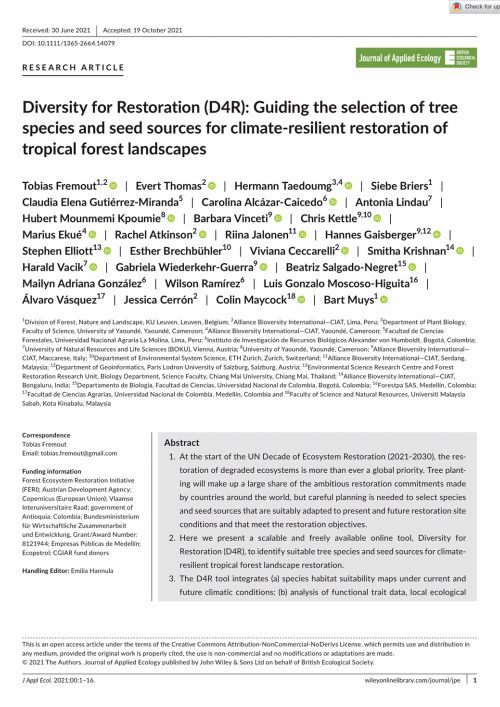Diversity for Restoration (D4R): Guiding the selection of tree species and seed sources for climate-resilient restoration of tropical forest landscapes

FORRU Contributors
ABSTRACT:
1. At the start of the UN Decade of Ecosystem Restoration (2021–2030), the restoration of degraded ecosystems is more than ever a global priority. Tree planting will make up a large share of the ambitious restoration commitments made by countries around the world, but careful planning is needed to select species and seed sources that are suitably adapted to present and future restoration site conditions and that meet the restoration objectives.
2. Here we present a scalable and freely available online tool, Diversity for Restoration (D4R), to identify suitable tree species and seed sources for climate-resilient tropical forest landscape restoration.
3. The D4R tool integrates (a) species habitat suitability maps under current and future climatic conditions; (b) analysis of functional trait data, local ecological knowledge and other species characteristics to score how well species match the restoration site conditions and restoration objectives; (c) optimization of species combinations and abundances considering functional trait diversity or phylogenetic diversity, to foster complementarity between species and to ensure ecosystem multifunctionality and stability; and (d) development of seed zone maps to guide sourcing of planting material adapted to present and predicted future environmental conditions. We outline the various elements behind the tool and discuss how it fits within the broader restoration planning process, including a review of other existing tools.
4. Synthesis and applications. The Diversity for Restoration tool enables non-expert users to combine species traits, environmental data and climate change models to select tree species and seed sources that best match restoration site conditions and restoration objectives. Originally developed for the tropical dry forests of Colombia, the tool has now been expanded to the tropical dry forests of northwestern Peru–southern Ecuador and the countries of Burkina Faso and Cameroon, and further expansion is underway. Acknowledging that restoration has a wide range of meanings and goals, our tool is intended to support decision making of anyone interested in tree planting and seed sourcing in tropical forest landscapes, regardless of the purpose or restoration approach.
Related Advice
Rapid site assessment
The concept and methodology to determine the level of degradation, which is related to activities should be implemented and the intensity of the work required for the target...
Automated Forest Restoration
These days, technologies are making restoration easier, from aerial surveys and monitoring to dropping seeds from drones. Learn more here.
Field Performance of Planted Trees
Monitoring is essential for adaptive management. Click here to learn how to measure tree survival and growth and find out if your restoration plan is working.

